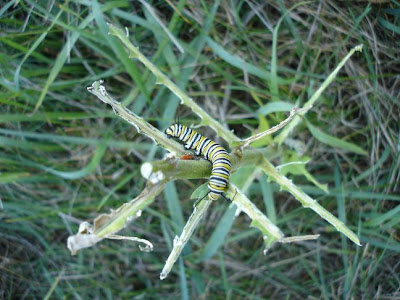 The caterpillar of the Monarch butterfly is a lot easier to photograph than its parent. There were two of them on what is left of this common milkweed plant in the hayfield. After I took this, I transferred them onto another milkweed nearby which had a few remaining leaves. Milkweed is the only thing that Monarch caterpillars can eat, so it is a desirable plant for people who want to encourage butterflies to their gardens, but it is considered a weed by farmers as it is poisonous to sheep.
The caterpillar of the Monarch butterfly is a lot easier to photograph than its parent. There were two of them on what is left of this common milkweed plant in the hayfield. After I took this, I transferred them onto another milkweed nearby which had a few remaining leaves. Milkweed is the only thing that Monarch caterpillars can eat, so it is a desirable plant for people who want to encourage butterflies to their gardens, but it is considered a weed by farmers as it is poisonous to sheep.Identifying all the wild flowers we're seeing is sometimes easy, sometimes hard. I was surprised to see Golden Rod growing all over the place - it's generally seen as a weed here, rather than as a desirable cottage garden flower, as in the UK.
 I found this flower last night - initially thinking it was a thistle, but then on close inspection realised that it was an aster. I think it is a New England Aster. The Wikipedia article mentions that this is another wild flower that was taken back to Europe as a garden plant.
I found this flower last night - initially thinking it was a thistle, but then on close inspection realised that it was an aster. I think it is a New England Aster. The Wikipedia article mentions that this is another wild flower that was taken back to Europe as a garden plant.On the other hand, the Canadian Thistle seems always to be considered a weed, although I rather like both its flowers and its seed-heads. The butterflies love them too.

 The bright red berries of this plant caught my eye this when out for my morning constitutional with the dog (who, by the way, has been waking us up repeatedly during the night ever since I wrote about how good he is at night-time). Its delicate lilac flowers look like those on potatoes, so I presumed that, like the potato, it would be a North American plant. Wrong again - it is Bittersweet Nightshade, which is European and poisonous and highly invasive. It does have some uses in herbal medicine though, so it's not a completely hopeless case.
The bright red berries of this plant caught my eye this when out for my morning constitutional with the dog (who, by the way, has been waking us up repeatedly during the night ever since I wrote about how good he is at night-time). Its delicate lilac flowers look like those on potatoes, so I presumed that, like the potato, it would be a North American plant. Wrong again - it is Bittersweet Nightshade, which is European and poisonous and highly invasive. It does have some uses in herbal medicine though, so it's not a completely hopeless case.
No comments:
Post a Comment